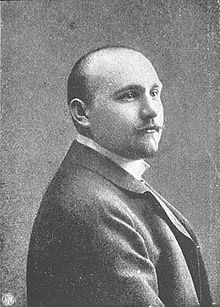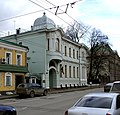Gustav Helrich
Gustav Helrich ( Russian Густав Гельрих * 15. September 1878 in Hamburg ) was a in Moscow active German architect . Name variants are Gustav August Helrich, Gustav Karl Julius Adolfowitsch Helrich, Gustav Andrejewitsch Helrich and Gustav Gulrich.
Life
Helrich studied at the Polytechnic School in Hanover . In 1901 he came to Moscow and received authorization from the Interior Ministry's Construction Committee to carry out construction work. He kept his German citizenship and ran a large private architecture firm . In 1901 he built a tenement house on Lesnaya Ulitsa for the trading and construction joint-stock company founded by J. Reck in 1899 , which has not been preserved. For J. Reck himself, Helrich built the J. Reck villa (1901–1903). In 1902 he built farm buildings for the entrepreneur W. P. Smirnow , son of the Vodka King PW Smirnov . Together with WW Sherwood and II Rerberg , he built the villa SG Protopopow-WS Tatishchev (Novokuznetskaya Ulitsa 12, 14) in 1902. 1906–1908 he built a tenement house for PA Skopnik (Uliza Spiridonowka 27).
In 1906 Helrich became a member of the Moscow Architecture Society. In 1908 he presented his projects at the International Art Exhibition in St. Petersburg . Helrich specialized in multi-storey apartment buildings in skeleton . He became an important representative of Moscow Modernism, which started out from Art Nouveau .
1910–1912 Helrich built a tenement house for EN Shevlyagina (Uliza Schtschepkina 22). In 1911 Helrich built the apartment house for the brothers Gribow and Jacob Recks, as well as a mausoleum for SP Smirnow in the Pyatnitskoje cemetery and a home with Maria Magdalena Church of the Society for the Education of Blind Children on Prospekt Mira. In 1912 the Utkin apartment building followed (Ulitsa Shtschepkina 25). In 1913 Helrich built a tenement house for himself on the Malaja Dmitrowka. which he owned until 1916.
In Juscha , Helrich built the Volkshaus (1910) and the secondary elementary school (1913) at the AJ Balin factory.
At the beginning of the First World War , Helrich closed his office and left Russia .
Works
Individual evidence
- ↑ a b c Naschtschokina MW : Московский модерн . 3. Edition. Коло, St. Petersburg 2011, ISBN 978-5-901841-65-5 .
- ↑ Зодчие Москвы времени эклектики, модерна и неоклассицизма (1830-е – 1917 годы): илл. биогр. словарь . КРАБиК, Moscow 1998, ISBN 5-900395-17-0 , p. 73-74 .
- ↑ SO Schmidt : Московская энциклопедия . Издательский центр Москвоведение, Moscow 2007, ISBN 978-5-903633-01-2 , p. 361-362 .
- ↑ a b c Справочник Научных Обществ России: ГЕЛЬРИХ Густав Курл Юлиус Адольфович (accessed December 19, 2017).
- ^ The Art Nouveau World: Gustav Helrich architect (accessed December 18, 2017).
- ^ Regeneration of an Early XX Century Apartment Building (accessed December 18, 2017).
- ↑ The mixed feelings. Prechistenka, 13 (accessed December 18, 2017).
- ↑ Gulrich House (accessed on 18 December 2017).
- ↑ Polyanka 44 (accessed December 18, 2017).
- ↑ Особняк Якова Рекка (С.Д. Красильщиковой) (accessed December 18, 2017).
- ↑ Вся Москва на 1916 год . Издание Товарищества А. С. Суворина Новое время, Moscow 1916.
- ↑ Муниципальная средняя общеобразовательная школа №3 ( Memento of the original from August 27, 2011 on WebCite ) Info: The archive link was automatically inserted and not yet checked. Please check the original and archive link according to the instructions and then remove this notice. (accessed December 19, 2017).
| personal data | |
|---|---|
| SURNAME | Helrich, Gustav |
| ALTERNATIVE NAMES | Gulrich, Gustav; Гельрих, Густав (Russian) |
| BRIEF DESCRIPTION | German architect in Moscow |
| DATE OF BIRTH | September 15, 1878 |
| PLACE OF BIRTH | Hamburg |
| DATE OF DEATH | 20th century |









